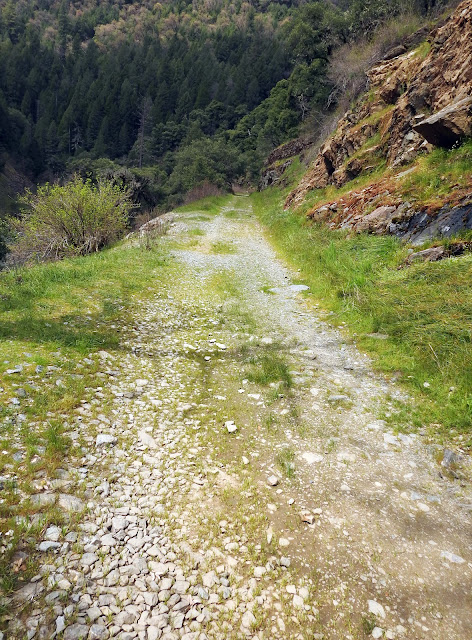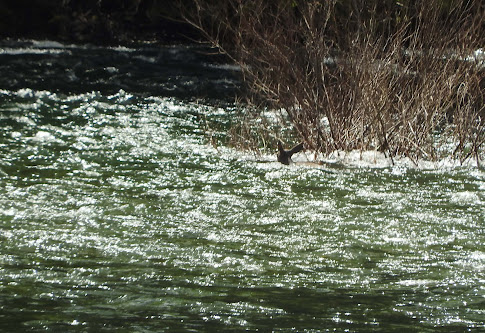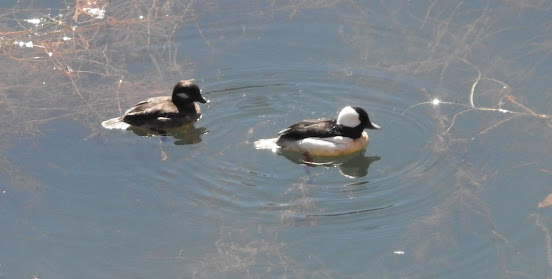American Dipper Nest - Day 1
The following information about American Dipper nests, nestlings, and fledglings is from the Cornell website at https://birdsoftheworld.org. The text does not correspond with the photos, but I wanted to post what the raising of a young American Dipper entails! For more information on the actual construction of the nest, check out my blog, "Spring Sightings", on March 31, 2023.
"The nest is a 2-part domed or ball-like structure with side entrance. Canopy of dome may overhang entrance hole to keep out water. Outer shell of moss with small amounts of interwoven grass (both stems and roots) and leaves. Inner chamber globular with woven cup or pad, composed of grass and leaves, sometimes bark.
American Dipper Nest - Day 2
Nest is well-insulated; seems adapted to control inside temperature (warm or cool, as necessary) and to keep inside dry. Thick outside mossy shell (3–5 cm thick) absorbs moisture; inside coarse grasses resist wetting.
American Dipper Nest - Day 3
Between completion of nest-building and laying of the first egg, 6–15 d lapse. Usually lays 1 egg/day, for a total of 4-5 eggs per clutch.
American Dipper Nest - Day 4
Incubation period 14–17 d . Female develops a large brood patch and does all incubation. Male carries food to female on nest, but she also feeds herself . Baby birds are altricial, and born naked except for sparse down. Chicks stay in nest about 25 d, sometimes longer. Both parents feed the chicks.
Video of an American Dipper compacting the moss in the walls of its nest!
American Dipper Nest - Day 5
Female broods regularly for about 1 week after hatching and continues to about day 16. During first few days, female broods for 5–61 min periods, leaves nest for 8–22 min periods. By day 16, nestlings nearly fill nest, so female enters nest with great difficulty and remains only a short time; only 2 brooding periods of 6 min each. Female enters nest by crawling over young birds; turns, stays in rear of nest. When male feeds young, female remains in back and young protrude heads from beneath her breast to receive food. Both parents deliver food to nestlings, the male more frequently while the female broods.
Completed American Dipper Nest - Day 6
Within the first hour after fledging, young bird moves around and takes quick steps. Starts dipping; frequency varies but increases when parents approach. Enters water, if shallow, and bathes by fluttering wings; can swim in water too deep for wading. May briefly poke head under water as if looking for food; picks at lichens and moss on rocks. Newly fledged young is active for about 1 h after leaving nest, then tires and stands still or preens. If not disturbed, typically remains within 12 m of nest. If young slips into water, it can use wings or feet to crawl out. Full flight not observed first day out of nest, but fledglings are able to flutter several meters back up to nest ledge. Parents feed young for widely varying periods (4–35 d) after leaving nest. Upon achieving independence, juveniles disperse."
A Note on Nest Watching
Nest watching is fascinating but you need to be careful not to disturb the nesting birds. You also do not want to attract the attention of other birds. If you stay and watch young birds in a nest for too long, you may be noticed by their predators. Here are a few of my suggestions:
Do not check the nest every day. Wait at least three days between observations.
Do not observe the nest for more than a minute, unless at a good distance.
Conceal yourself if possible, so that the nesting birds are not disturbed, and that predators don't watch you watching.
Here are a few additional tips from the Cornell Ornithology Lab:
"Do not check in the early morning. Most birds lay their eggs in the early morning so plan on visiting nests in the late morning or afternoon. Also, most adults will temporarily leave the nest when you are near, and eggs and young nestlings can become cold quickly if left alone in the early morning.
Avoid nests during the first few days of incubation.
Do not approach nests when young are close to fledgling. When the young are disturbed during this stage, they may leave the nest prematurely. Young that fledge prematurely usually do not stay in the nest despite attempts to return them, and their survival rates away from or outside the nest are low.
When young birds are fully feathered and very alert, only observe the nest from a distance.
Avoid nests during bad weather. If it is cold, damp, or rainy, postpone checking nests until another day. Checking nests during this time can be very stressful for birds.
Do not check nests at or after dusk, when females may be returning to the nest for the night. The exception to this would be owls, which typically leave the nest at dusk."
A Note on Nest Collecting
To my annoyance people often take the Dipper's nest mentioned above, usually after the nesting season. If they left the nest, the Dippers would possibly reuse parts of it, or "refurbish" it and reuse it the following year. What most people don't know is that it is illegal to collect migratory bird species nests. Dippers are NOT migratory birds, but I always think it is better to leave nests alone. The following information about Migratory Bird Nests is from the Fish & Wildlife Service at https://www.fws.gov/story/bird-nests.
"Most bird nests are protected under the Migratory Bird Treaty Act (MBTA). The Migratory Bird Treaty Act of 1918 (16 U.S.C. 703-712) implements four international conservation treaties that the U.S. entered into with Canada in 1916, Mexico in 1936, Japan in 1972, and Russia in 1976. It is intended to ensure the sustainability of populations of all protected migratory bird species. This law says: “No person may take (kill), possess, import, export, transport, sell, purchase, barter, or offer for sale, any migratory bird, or the parts, nests, or eggs of such bird except as may be permitted under the terms of a valid permit…” Under the MBTA it is illegal to destroy a nest that has eggs or chicks in it or if there are young birds that are still dependent on the nest for survival. It is also illegal for anyone to keep a nest they take out of a tree or find on the ground unless they have a permit to do so issued by the U.S. Fish and Wildlife Service."
Wild Turkeys (3 females) - Meleagris gallopavo
New Arrivals!
It's Springtime and migratory birds are arriving every day, and wildflowers are blooming! Almost every day something surprises me, like these three American Turkeys in my neighbors' yard! We have never had turkeys in our neighborhood! They usually inhabit the foothills! I was surprised how camouflaged they were in the blackberry thicket. It will be interesting to see if they stick around!
Although Wild Turkeys usually inhabit the local foothills, they have been documented in the Sierra up to 10,000' in elevation! They are not native to Calfornia but were introduced from Mexico in the early 1900's. They were also introduced as late as 1997 into the higher elevations of Sierra, Nevada, and Placer Counties, by the CA. Dept. of Fish and Wildlife, the U.S. Forest Service, and the National Wild Turkey Federation. This has proven to be a detrimental introduction, as the turkeys compete with the native grouse and quail. They do not stay during the winter snows, so they must walk quite a distance to their winter habitat in the foothills! Perhaps the drier, hotter, drought years have driven them to higher elevations. The following information is from the Cornell website allaboutbirds.org.
"Wild Turkeys get around mostly by walking, though they can also run and fly—when threatened, females tend to fly while males tend to run. At sundown turkeys fly into the lower limbs of trees and move upward from limb to limb to a high roost spot. They usually roost in flocks, but sometimes individually. Courting males gobble to attract females and warn competing males. They display for females by strutting with their tails fanned, wings lowered, while making nonvocal hums and chump sounds. Males breed with multiple mates and form all-male flocks outside of the breeding season, leaving the chick-rearing to the females, The chicks travel in a family group with their mother, often combining with other family groups to form large flocks of young turkeys accompanied by two or more adult females."
White-crowned Sparrow (male) - Zonotrichia leucophrys
Recently arrived from the foothills or perhaps Mexico! He will mate and raise his young here in our neighborhood.
Meadowlark (adult) - Sturnella neglecta
Recently arrived from the foothills or the central valley of California! This Meadowlark won't stay here and nest. It will probably migrate over to Sierra Valley to raise its young.
Black-headed Grosbeak (male) - Pheucticus melanocephalus
Recently arrived from Mexico! These lovely Grosbeaks will stay and raise their young here, or perhaps at a little higher elevation in the area.
Brewer's Blackbird (male-female) - Euphagus cyanocephalus
Recently arrived from the foothills or central valley of California! These Blackbirds raise their young right in our neighborhood every year!
Sicklepod Rock Cress - Boechera sparsiflora
These lovely, pink Sicklepod Rock Cress flowers popped up this week! They are about two feet tall and are one of the early bloomers in our area.
Oregon Grape - Berberis aquifolium
Oregon Grape is an early blooming shrub that is in full bloom right now.
It attracts lots of native pollinators.
Western Rue Anemone - Enemione occidentale
These delicate little flowers can be found on damp shady slopes.
Currently there are lots of them growing on the forest floor.
Grand Hound's Tongue - Adelinia grandis
The name Grand Hound's Tongue, refers to the large pointed leaves of this plant.
What's happening on the Canyon Creek Trail?
What's happening in the Lakes Basin?
Check back next week for the answers to these questions and more.
Your questions and comments are greatly appreciated. Please email me at northyubanaturalist@gmail.com.















.jpg)

.jpg)

































